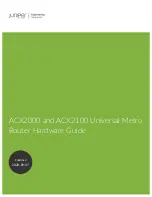
Terminal Operation 4-9
PRISM 3021
NET MLB: (Maintenance Loopback): As shown in diagram
4 of Figure 4-10 on page 4-11, the NET MLB command
loops data at the E1 DTE port back toward the network
(passes network data to the DTE and returns data to the net-
work). The MLB affects only network channels assigned to
the E1 DTE.
DTE MLB: As shown in diagram 5 of Figure 4 -10 on page
4-11, the E1 DTE MLB command loops all network data
back toward the DTE ports at the network interface. Data
passes through to the network. Set the E1-NET Timing to
Internal when this loop is enabled.
DTE LLB: As shown in diagram 6 of Figure 4-10 on page
4-11, the E1-DTE LLB command loops data received at the
E1-DTE interface back toward the E1 DTE (all DS0s are
returned to the E1-DTE port). The E1-DTE data is also
passed to the network.
E1 U
NLOOP
The unloop field causes the unit to take down the currently
displayed loop. This field usually reflects the current loop.
P
ORT
L
OOP
This field is used to loop high-speed data port from the net-
work back to the network and data from the DTE back to
the DTE as shown in diagram 7 of Figure 4-10 on page 4-
11. The Port Loop may be activated by receipt of inband
V.54 fractional loop code or by this field.
P
ORT
U
NLOOP
The unloop field causes the unit to take down the currently
displayed loop. This field usually reflects the current loop.
BERT
These fields control the Bit Error Rate Test feature. BERT is
performed on an interface and preempts user data. The
choices are provided below.
IDLE: The unit runs BERTs on the idle channels.
E1 NET: The unit runs a BERT on the E1 network data
channels.
DTE NET: The unit runs a BERT on the E1-DTE data
channels toward the network.
One NET: The unit runs a BERT on the data channels
assigned to Port One toward the network.
One DTE: The unit runs a BERT on Port One data channel
towards external equipment.
Channel 0 through 31: The unit runs a BERT on the
selected data channel. The channel must be unassigned.
P
ATTERNS
This field specifies the pattern transmitted during a BERT,
including BERTs initiated from the front panel switch.
Modifying this field does not cause the pattern to be trans-
mitted (refer to Start Test below). The choices are QRSS,
63, 511, 2047, 2
15
, 2
20
, 2
23
, 1:8, 3:24, ALT, and CLEAR.
T
EST
L
ENGTH
Defines the run-time of test pattern generation and error
accumulation. The choices are 15 min, 30 min, 60 min, 24
Hour, and Continuous.
P
ATTERN
S
YNC
This field displays the current state of pattern sync during a test.
If no test is in progress, NO TEST is displayed. If a test is
active, but the receiver is not in pattern sync, NO SYNC is dis-
played. If the receiver is in pattern sync, IN SYNC is displayed.
E
LAPSED
T
IME
Displays the amount of time elapsed since a timed test
began or, if completed, the total test time.
B
IT
E
RRORS
Displays the total number of bit errors detected since the test
began or since error statistics were cleared (up to 999,999).
E
RRORED
S
ECONDS
This field displays the number of asynchronous errored sec-
onds that have been detected since the test began or since
error statistics were last cleared. This parameter includes bit
error seconds and sync loss seconds.
% EFS
This ratio is derived from the number of error-free seconds
divided by the number of seconds accumulated in Elapsed
Time.
S
TART
T
EST
Pressing ENTER with the cursor on this field starts the
selected test pattern. TEST IN PROGRESS appears once the
test has started and the field changes to STOP TEST. To end
the test, press ENTER on STOP TEST.
R
ESET
E
RRORS
Pressing ENTER with the cursor on this field causes the test
error results to be cleared to zero.















































